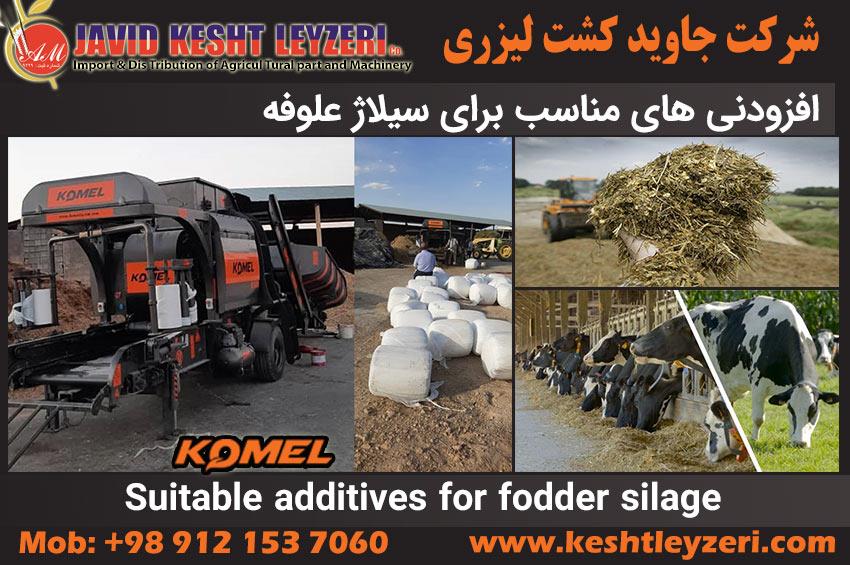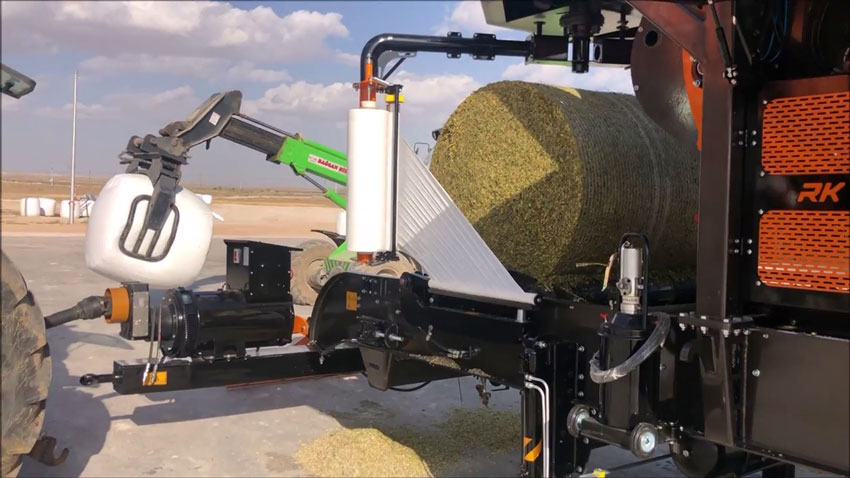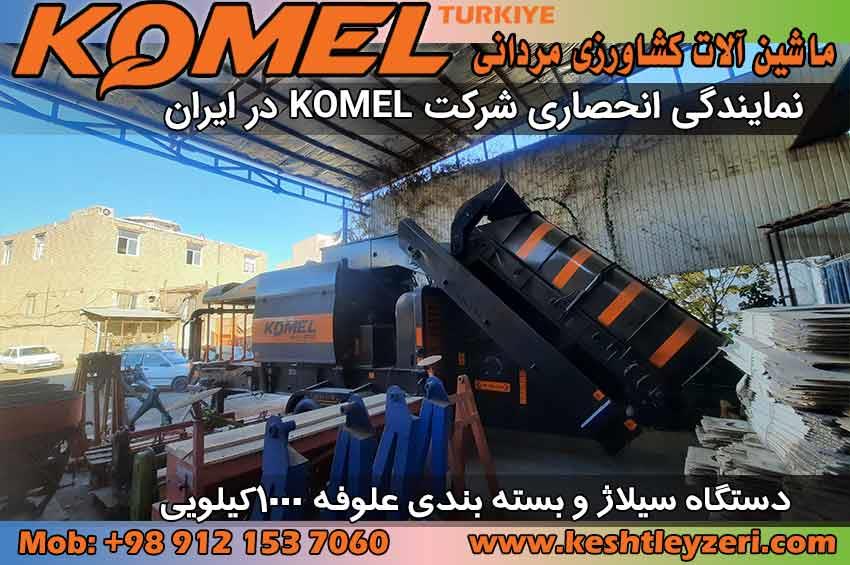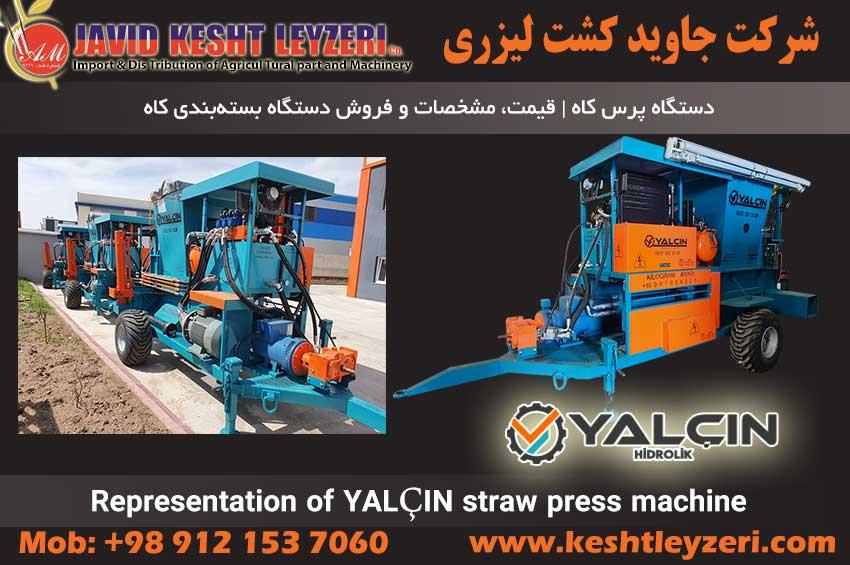
Suitable additives for fodder silage
javid keshtleyzeri Co.ltd
Fodder silage or packaging of fodder corn, alfalfa and other fodder is one of the necessities of today's industrial livestock farms to provide animal feed and animal processing.
Since the quality of silage depends on the fermentation process in the silage, which is carried out by lactic acid-producing bacteria, using the knowledge of biotechnology, products in which such bacteria, with very high density, are placed on the market have been offered
If these products are of an efficient type, they can speed up the fermentation process in the mass of silage corn and alfalfa by quickly producing a large amount of lactic acid, and by establishing stability in the silage, they can stop the activity of unwanted molds, fungi and bacteria and prevent spoilage, and Prevent the loss of silage dry matter.
Lack of decision making by ranchers
Although the economic benefits of using these biological additives have been scientifically and experimentally proven, some farmers are still hesitant about whether it is better to use this additive or not. In this context, ranchers face three obstacles:
1- Most of the time, it is difficult to tell the difference between silage grown with these additives and silage without additives.
2- Although it is not impossible, it is very difficult to reliably estimate the quality of silage in animal husbandry, due to the involvement of various factors. Only experts with enough experience can understand the quality of silage and its difference from normal silage.
3- In today's bustling market, dozens of biological additives to silage have been put on the market, and livestock farmers cannot easily accept the claims made by the producers of additives that are new to the market and their effectiveness has not yet been proven in the country's livestock farming conditions.
Various claims
Each manufacturer or seller of biological additives makes claims in the following areas:
1) Type and strain of the main additive bacteria
2) Auxiliary bacteria
3) Other substances, such as enzymes
4) The number of bacteria per gram of silage.
5) Additive efficiency in:
• Accelerate the fermentation process
• Prevention of mold on the top of the silo
• Prevention of dry matter loss
• Improving the digestibility of ensiled fodder
• Prevention of waste when harvesting from the silo
• Making silage palatable
• Gaining more weight (calves, heifers and breeding livestock)
• And finally, raising the average milk production
Essential knowledge
A little more knowledge about this claim can be beneficial for ranchers.
The type and strain of the main bacteria
What causes the main difference between the performance of these additives is the "natural ability of bacteria" to produce lactic acid. Lactic acid is the main acid for a good forage fermentation.
It's a strong, delicious acid that comes from the activity of Lactobacillus bacteria, which convert forage sugars into lactic acid.
Lactobacilli are of two groups:
• Lactobacilli that convert forage sugar into lactic acid only, and in the process, no energy or dry matter from silage is wasted (homofermentative lactobacilli).
• Lactobacilli that make some lactic acid, acetic acid (vinegar), ethanol (alcohol), amines, and carbon dioxide from forage sugar. In the process, a large amount of energy and dry matter is lost, and the fermentation process is slow and slow (heterofermentative lactobacilli).
The most suitable bacteria for feed additives are Lactobacillus plantarum (homofermentative) bacteria. Auxiliary bacteria are additives whose main bacteria, although they are of homofermentative lactobacillus type, do not have the ability to start activity from high pH and their acid production power and speed are low.
Some manufacturers include one or more helper bacteria in the additive to help the main bacteria. Although the supply of these "multi-bacterial" additives is a new work, it is not considered a suitable solution because it has several weaknesses, the most important of which is the inability of "multi-bacterial" additives to dominate the bacterial environment of the silage mass.
Another problem with these additives is that although the number of bacteria in them is high, not all of them start working at the same time.
For example, an additive that contains 50% Lactobacillus plantarum and 50% Pediococcus, although it provides 100,000 bacteria per gram of fodder, but only 50% of Pediococcus is activated in the initial critical stage of fermentation (pH 5.6 to pH 3.5) It does nothing of value for fermentation, and 50% lactobacillus must wait until the pH in the silage drops to pH 5.
Obviously, the desired situation is to have a viable bacterium that can become active from a pH of 5.6 and start producing lactic acid and remain active until the developmental stage of fermentation (pH 8-3.4).
It is natural that a strong and efficient lactobacillus does not need helper bacteria, and "multi-bacterial" additives are not very useful for fermentation and increasing milk production.
enzymes
No research has yet been published that proves the usefulness of enzymes in improving fermentation or increasing milk production. At the same time, it is not bad to say that the amount of these enzymes in additives is so small that they cannot have any effect on silage fodder.
In fact, these enzymes are used as "marketing tools" and do not contain any properties.
The number of bacteria in the additive and their abundance in the silage has been known that each additive to the silage should have the amount of bacteria that after being sprinkled on the fodder, at least one hundred thousand efficient homofermentative lactobacillus bacteria will reach each gram of fodder.
Additives whose manufacturing technology is carried out by the continuous culture method, start to grow after activation and their number increases until reaching the peak of growth, but other additives that have reached their peak growth during the production stage after the start of activity in the silo Their life span decreases and their number decreases.
Additive efficiency
In speeding up the fermentation process:
In nature, in the fodder field, a large number of different bacteria, fungi, and molds live on the plant, which immediately after picking and chopping the fodder, begin to grow by consuming dry materials.
It is clear that a group of these same bacteria (homofermentative lactobacilli) with good management can make a good silage, but because the number of effective Lactobacillus plantarum is small and weak in the field, the fermentation process takes a long time. (loss of dry matter) and palatability and digestibility of silage are not the best.
It is to compensate for this deficiency that biological additives have come to the market. In fact, a good additive combined with good management will bring benefits to livestock husbandry many times its cost.
Mold prevention
Air is the main enemy of silage. Air contact with silage in any condition causes the activation of molds, fungi and aerobic bacteria that consume dry forage materials.
Preventing mold on the top and sides of silage is a management task, and no additive can prevent mold and spoilage when the silage is not properly covered and weighed down, and air is exposed to the ensiled forage.
The claims made in the efficiency to prevent the mold and growth of fungi in the silage top are not correct.
The effectiveness of additives in preventing spoilage and mold within the silage mass can also be true provided that the biological additive has a strong and efficient strain of Lactobacillus plantarum that starts its activity as soon as it is added to the silage.
Prevention of waste when harvesting from the silo
Some additives can partially compensate for the weakness of harvest management when harvesting from the silo. The main bacteria of these additives is a heterolactic bacterium that produces a large amount of acetic acid.
Acetic acid temporarily prevents the activation of fungi and molds when the silage comes into contact with air again. In this context, two points should be remembered:
Fermentation of silage with heterolactic lactobacilli is very slow, and in some cases it is very late and may never reach the stability stage, for this reason, a considerable amount of forage dry matter is lost in the fermentation process.
As a result, the nutritional value of silage is greatly reduced. This amount of loss of nutritional value is much greater than what might be caused by poor management of silage harvest.
The number of livestock farms whose silage management is so poor that they take the silage from the silage to the manger 48 hours later, for example, is very small. It should be emphasized that in any case, livestock farmers should take the silage harvested from the silage to the manger in the shortest possible time and harvest 15 to 30 cm thick silage from the entire forehead every day.
Prevention of loss of fodder dry matter
Immediately after the fodder is picked and chopped, various bacteria, fungi and molds that are on the fodder plant are activated and the consumption of the dry matter of the fodder and its nutritional value begin to decrease.
Enzymes of the fodder also break down proteins. This process starts from the field and continues in the silage until the air in the silage is exhausted (usually 48 hours for well-threshed silage).
But the activity of some microorganisms and molds, which do not need much air, and tolerate a weak acidic environment, continues. It is at this stage that some molds produce harmful mycotoxins.
The only way to reduce the loss of dry matter and prevent spoilage in the mass of silage fodder is to speed up the fermentation process and shorten the period of activity of aerobics, fungi and molds. This is possible only by using a strong homolactic bacterial additive, which does not require auxiliary bacteria.
Improving digestibility of ensiled forages Why silage prepared with some bacterial additives can increase milk production is still not well understood. Some scientists consider several factors to be effective in this field:
• Some bacterial additives increase the digestibility of silage.
• Delicious silage with some additives is eaten more by cows.
• The last study that was published in the summer of 2010 shows that the addition of MTD/1 by changing the composition of the bacterial flora of the cow's rumen has caused an increase of 800 grams of milk per day.
Silage flavoring
Lactic acid is the tastiest and strongest acid produced in forage silage.
Acetic acid (vinegar) reduces the palatability of silage, and butyric acid gives silage a very unpleasant odor. Although a cow will eat whatever is available if it is hungry, it is obvious that it will eat more of the tasty silage.
Higher weight gain (calves, heifers, dairy cows) Trials have shown that silage grown with an efficient homolactic bacterial additive can increase livestock weight gain.
In an informal experiment in the Middle East (Iran), cows fed on silage grown with MTD/1 additive gained 84 grams more weight per day compared to the control group.
And finally, increasing milk production
As mentioned, it is not yet clear why feeding silage grown with certain additives can increase milk production. So far, only three types of bacterial additives have been able to increase milk production in cows in independent academic farm trials.
All three of these additives had only one homolactic bacterium (Lactobacillus plantarum - various strains) and were without auxiliary bacteria and enzymes.
Among these, the additive with MTD/1 bacteria has been able to increase milk production in 15 independent university experiments, the latest results of which were published this summer, and has achieved a better record than the other two additives.
The best way for ranchers to make decisions
With all these claims made by manufacturers and sellers of bacterial additives, what should farmers do to make a decision?
• There is no doubt that some bacterial additives are effective in increasing milk production and animal weight by improving and speeding up the fermentation process, but not all of them.
• However, supplement sellers must provide farmers and experts with evidence to support their claims:
These documents, according to the global scientific practice, should show the published positive results of 5 independent academic tests, to ensure the continuity of the additive effect.
• Short shelf life makes any product vulnerable.
Some additives have a lifespan of less than a year, which is a sign that their manufacturing technology is not advanced.
Maintenance
The easier the additive's maintenance conditions are, the more efficient it is. Additives that require refrigeration are vulnerable, especially if storage conditions are not always available in the consumer country.
Ensure efficiency
Any product, in addition to having a proven scientific basis, should be suitable for use in regional conditions, and the bacterial fodder additive should be able to work on all fodder, with low or high moisture percentage, and with different levels of resistance to fermentation. be
Experiences gained in other farms can be a very good guide to ensure the product's effectiveness.
Result
Based on the features of the additive offered to them, and the points mentioned above, breeders can ask additive sellers to:
1- Documented scientific documents from the results of at least 5 independent university pharmaceutical experiments proving the additive effect in improving fermentation and increasing milk production
2- And the positive results that livestock farmers have obtained from consuming their products in previous years and make a decision according to the other points mentioned in this article.
Certainly, fodder silage using modern fodder packaging machines can have a great effect on increasing the quality of silage, you can click on the image and link below to view the images of fodder packaging machines and consult with Our experts, make your best decision and choice in optimizing silage quality:
KOMEL 1200 kg corn packing machine, new series of trolley cash model 2022








